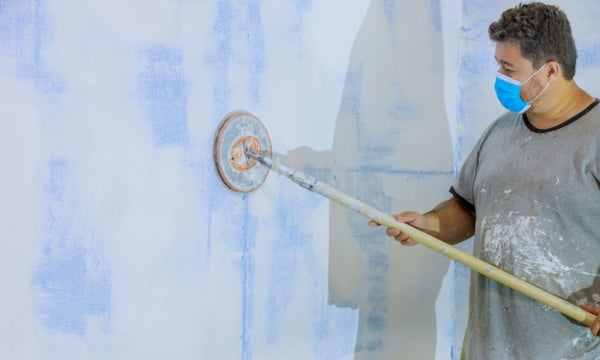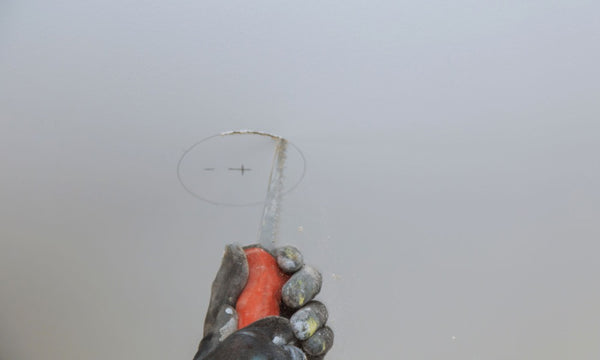Award Winning Service
Award Winning Service

Drywall installation and finishing is a critical step in any construction or renovation project. Whether you're working on a small home improvement project or a large commercial job, the quality of your drywall installation and finish can make a significant impact on the final outcome of the entire project. It is critical to use the proper tools and equipment to achieve a smooth and seamless finish.
Using the incorrect tools or equipment can result in errors, delays, and even costly rework. That's why we've created this guide to assist you in selecting the best drywall tools and equipment for your project. We've compiled a list of expert-recommended tools, ranging from drywall screw guns and sanders to taping knives and mud pans, to help you achieve professional results.
In this post, we'll go over why it's critical to use the right drywall tools and equipment for a successful project. We'll also make expert recommendations for essential drywall tools and equipment, as well as provide tips on how to use them effectively. You'll have a better understanding of some of the tools and equipment required to achieve a smooth and seamless drywall finish by the end of this post.
To achieve a smooth finish, sand the drywall after taping and finishing it. There are several types of drywall sanders, including pole sanders (radial and normal rectangular sanders), hand sanders, and electric power sanders.
If you're looking for a professional-grade pole sander, we recommend the USG Sheetrock Pole Sander. It includes a universal joint for increased mobility and control. The USG Sheetrock Pole Sander also has a low center of gravity and no flip design, which helps to prevent wall gouging. The pole sander is ideal for sanding large, flat surfaces and has a comfortable grip that aids in reducing hand fatigue. To avoid damaging the drywall, use fine-grit sandpaper and wear a dust mask and eye protection to avoid inhaling the dust.
To avoid sanding too much in one spot, move the drywall sander back and forth in a slow, even motion. To avoid clogging and reduce the risk of scratches, keep the sandpaper clean.

Contractor using the Radius 360 Radial Drywall Pole Sander
A taping knife, also known as a sheetrock knife, is used to apply joint compound to drywall joints. Consider the blade material when selecting a taping knife, as it can affect the tool's flexibility and durability.
The most common taping knife sizes are 6", 10", and 12", but professionals also commonly use 8" and 14" taping knives. Timothy's Toolbox carries a wide selection of taping knives, including sets of expertly selected taping knives in popular sizes. Our drywall taping knife sets make it simple to select the appropriate sizes for your project. In addition, For a seamless finish, apply the joint compound in a thin layer with a taping knife and use long, even strokes.
A drywall screw gun is a power tool used for fastening drywall to wood or metal studs. Usually drywall screw gun features a depth adjustment system that allows you to control the depth of the screw, which is important for achieving a smooth and even finish. This tool is particularly useful when using a large amount of drywall screws in the job is necessary. The screw gun is a time-saving tool that can significantly speed up the installation process.
We recommend the DeWalt Drywall Screw Gun, which features a lightweight design, ergonomic grip, and a depth adjustment system that allows you to precisely control the depth of the screw. The DeWalt screw gun also features a nose cone that helps to prevent the screws from stripping, which can be a common problem when using a regular drill. When using a drywall screw gun, be sure to choose the right screws for your project. It is important to use the right length of screw to avoid damaging the drywall or the studs.
A jab saw is a small saw used for cutting holes in drywall for outlets, light fixtures, or plumbing. The "jabbing" function is the main feature that differentiates it from other cutting tools. The jab saw features a sharp pointed tip that allows you to pierce the drywall before cutting, making it easier to start a cut without damaging the surrounding drywall.
There are many great jab saws on the market. One of those great jab saws that are experts recommend is the Hyde 6” Maxxgrip Jab Saw, which features a comfortable grip and a sharp point that penetrates drywall without drilling. It also features a double-ground high carbon steel teeth that allows for cutting in both directions. The jab saw is also useful for cutting through other materials such as wood, plastic, or metal.
Before making any cuts with a jab saw, mark the area to be cut with a pencil. To avoid damaging the surrounding drywall, cut slowly and carefully, and use the jabbing function to create a starting point for the cut.

Picture shows a jab saw being used to make a circular cut in drywall. Note the contractor used a pencil to draw out the cut prior to making the cut.
A mud pan is used to hold joint compound while applying it to drywall joints. The mud pan is an essential tool for drywall finishing, as it provides a convenient and portable solution for holding the joint compound while you work. Mud pans come in a variety of sizes and materials, but stainless steel is the most common, and the most common sizes are 10", 12", and 14".
The Advance Equipment HeliArc Mud Pans, which have a smooth and durable surface, are the most popular stainless steel mud pans. The Advance mud pans have tapered edges that makes it easier to load the joint compound onto the taping knife and apply it to the drywall. Additionally, the mud pans have an optional non-slip grip that allows you to hold it securely with one hand while you work.
Some people still prefer to use a hawk and trowel over a mud pan and taping knife combination. Traditional drywall finishing tools such as the hawk and trowel are still used by some professionals today. The hawk is a flat, square-shaped metal plate used to hold joint compound, whereas the trowel is a handheld tool with a flat, rectangular blade used to apply joint compound to drywall joints. The use of a hawk and trowel requires more skill and practice than the use of a mud pan and taping knife, but some people prefer the control and flexibility it provides.
When using a mud pan, be sure to clean it regularly to avoid dried joint compound from building up and affecting your work. Remove any excess joint compound with a putty knife and clean the mud pan with a damp cloth.
A corner trowel, also known as a corner tool, is used to apply joint compound to the inside corners of drywall joints. The corner trowel is designed to fit into tight corners and apply joint compound in a smooth, even manner.
The Marshalltown Corner Trowel, with its flexible blade and comfortable handle, is our recommendation. The flexible blade makes it easy to apply joint compound, and the handle provides a comfortable grip for extended use.
Apply a thin layer of joint compound to the inside corner and smooth it out evenly with a corner trowel. To avoid creating air pockets or ridges in the joint compound, use long, even strokes.
Overall, a corner trowel is an essential tool for achieving a professional finish on your drywall project. With the right technique and tools, you can create smooth and seamless joints that will enhance the appearance of your walls and ceilings.
A drywall hammer is a specialized tool used for hanging drywall. Unlike a regular hammer, a drywall hammer features a flat face and a hatchet blade that can be used for cutting drywall or trimming excess material. The hatchet blade is also useful for creating openings for outlets or switches.
Professional drywall hangers and framers frequently recommend the Ox Pro Series 14oz Drywall Hammer. When using a drywall hammer, be sure to choose the right weight for your task. A heavier hammer can make it easier to drive nails into studs, while a lighter hammer can reduce hand fatigue when working on overhead projects.
When working with drywall, it is critical to use a drywall hammer rather than a regular hammer. A regular hammer can cause drywall damage, dimples or dents, and loosening of screws or nails over time.
Here are some essential tips for using drywall tools and equipment:
By following these tips, you can ensure that you are using your drywall tools and equipment correctly and achieving the best possible results.
Drywall projects can be daunting, but with the right tools and equipment, you can achieve professional results. The drywall screw gun, drywall sander, taping knife, putty knife, jab saw, mud pan, corner trowel, and drywall hammer are all available at Timothy's Toolbox. You can tackle your drywall project with confidence and a smooth and seamless finish by selecting the right tools and following our essential tips. Do not hesitate to reach out to our experts for further guidance on your drywall project needs.
0 of 3 items selected
Leave a comment